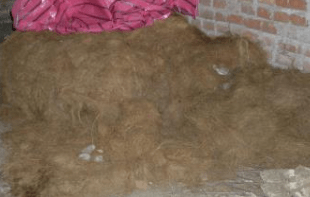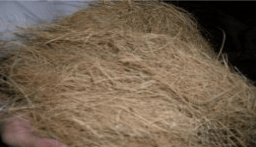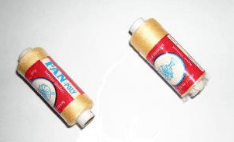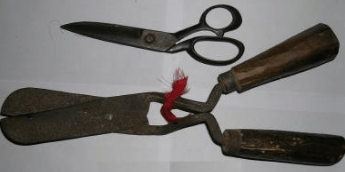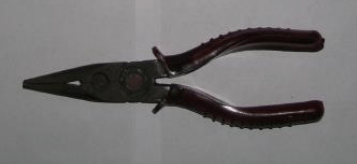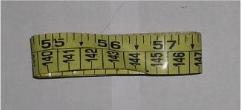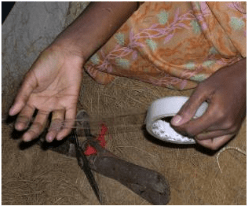Woven magnificence is what you see in a coir product. The efforts behind manufacturing the raw materials are huge and involve several processes. Coir is a totally natural, eco-friendly and exceptionally tensile fiber extracted from the nuts of coconut palms. This natural wonder is available in abundance and finds various applications. A natural product, coir being biodegradable, environment friendly and echo proof makes it a high quality product from an eternally renewable source. The coconut palm has been eulogized as ‘Kalpvriksha’ the all giving tree in the classics of India. The use of coconut throughout India makes it a symbol of national unity. Woven magnificence is what you see in a coir product. Coir or coconut fibre is used very artistically to make a wide range of eco-friendly toys, wall hangings, key rings, Christmas hangings, pen stands and other home decorative. Coir products are 100% natural. This craft is unique as it is produced only in Orissa and not in any other coconut rich states of India.
Global Presence
Fifteen countries of the Asia -Pacific region produce 86% of the coconut in the world. But only a handful of them are known to be coir producers. . India is the largest producers and exporter of coir and coir products. Sri Lanka, Indonesia, Malaysia, Philippines, Thailand and now Vietnam are the other primary producers of coir with varying levels of production capabilities. Value addition in coir is at its best in India where the fibre is converted into exquisite floor coverings, Geo textiles, etc. which have earned a name in the International market. The coir industry, which was confined to Kerala, has now spread to other states like Tamil Nadu, Karnataka, Andhra Pradesh, Orissa, etc. over the years largely on account of various developmental and promotional programmes.
Practitioner Community
There are various castes and tribes in the village of Siriapur in Patnaika situated in Puri District such as Vaishya, Khandayak, Silcot, Dhobi, Brahmins. These people are mainly farmers who do farming in the suitable seasons.
Material
Raw material required for making coir toys and other coir products are very few and basic.
Coir
Coir is traditionally processed from coconut husks cured in saline or freshwater for eight to ten months by process called “Retting” for increasing the flexibility, strength and durability of fiber.
Availability
Earlier coir used to be transported from Kerela. Nowadays, it is available in the local markets of Orissa.
The Wonders of Coir Fibre
• Moth-proof
• Resistant to fungi and rot
• Provides excellent insulation against
• Temperature and sound.
• Not easily combustible
• Unaffected by moisture and dampness
• Tough and durable
• Resilient
• Easy to clean
• Totally static free
Fevicol
Fevicol is diluted with water and then used for pasting the fibre on the main body. After the completion of the product it is to be dipped in diluted fevicol for durability and stiffness.
Wool
Coloured wool is used for surface ornamentation of coir products.
Cardboard
This is used provide proper shape and stiffness. The card board is cut into required shapes then fibre is stuck over the board.
Cotton thread
Cotton thread is used to wrap the forms or products made of coir fibre. This helps the product take a definite and a stable form.
Tools
Simple hand operated tools are used for making coir toys.
Scissors
Two sizes of scissors are used for different purposes. Small scissors are used for cutting thread and other small things. Big scissors are used for cutting the coir fibre.
Pliers
It is used while stitching; it is used for plucking out the needle from the coir toy.
Needle
It is used for stitching. The size of the needle depends on the type of work
Measuring tape
It is used for measurements.
Cello tape (adhesive tape)
Workers use cello tape to wrap it on their fingers so as to prevent them from being cut by the stiff coir or by thread while tying the toys.
Process
The coir fibre is first sorted out and separated on the basis of their colour and other similarities. For making a toy, firstly, the design is to be finalized and made on the paper.
Then according to the design they work on the proportion of the toys.
For simple and small products, the coir is simply tied with the thread to make desired products. Sometimes if the product is quite small for instance, a leaf then cardboard is cut into that shape and then coir is tied on it with thread and fevicol.
A big toy or product is worked out in different parts. Different parts are made by different people and then all the parts are assembled together with the help of thread, needle and fevicol.
Coloured wool is used for surface ornamentation like for eyes, clothes etc. depending on the design. Use of colour wool also enhances the look of the toy. For value addition, wooden beads and metal bells are also used].
After the completion of the toy or product, it is dipped into diluted fevicol. This is done, so that the thread stiffens up and does not open up. Fevicol solution provides 9better durability and stability to the product or toy. The final product may take two days to six months to complete depending upon the size of the product.
Products
Products made out of coir fibre are mainly decorative products. The toys made of coir are very popular as Educational products, used for teaching children in nursery and kindergarten schools. Some utility products have come into existence during recent times.
The product range consists of:
•Toys
•Wall hangings
•Pen stands
•Coasters
•Magazine racks
•Decorative items
Innovations
Apart from its traditional use as rope, yarn, and floor coverings, coir fibre is finding new applications as an eco-friendly substitute for wood and synthetics. It is a long term bio-degradable geo-fabric for soil bio engineering and garden articles. The by-product of coir industry, coir pith, is increasingly being used as a soil conditioner. The future of coir industry depends on the non-traditional areas and non-conventional products.
Challenges
Quality Assurance
Quality of coir products is often difficult to maintain because of the very nature and availability of the raw-materials like fibre, yarn, dyes, chemicals, etc. Besides, the production infrastructure like looms are obsolete and often in dilapidated condition. The workmanship of thousands of skilled and semi-skilled workers vary substantially that homogeneity and standardization are hard to achieve. Obviously quality is the casualty. Training for skill development and extension programmes for quality up gradation of the widely scattered tiny household units and their maintenance are critical in improving the current state of affairs.
Market Intelligence
Inadequacy of ready to use information keeps the manufacturers, mostly small in size, ignorant of the market condition and consumer preferences -a situation that no industry can afford in this era of globalization. The Coir Board has recently set up a Coir Trade Centre at Kochi, which hopefully would meet this badly felt need of the industry


